Thanks for your interest in buffalo! We are bringing you a combination blog and website.
My assistant Ronda Fink and I have produced books and websites, but never before a blog. So this is more than a first issue—it’s a new venture for us!
But not a new topic. Buffalo are old as the hills in the northern plains. We know them. Yet they are still surprising us with their wild nature and amazing capers.
Our mission is first of all—to help young people get to know and love the magnificent buffalo/ bison—America’s new National Mammal! This means teachers need to be involved.
So this is first of all for teachers and their students! Especially Native American students who have a special awe and pride in their buffalo.
And of course, we invite everyone who has a soft spot in your heart for buffalo. Come along on this incredible journey. We won’t let you down!
You can be an expert of sorts on this very specific subject. It’s a fun topic.
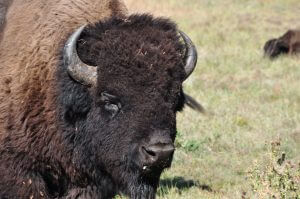
The American Bison became the official National Mammal of the United States on May 9, 2016, when President Obama signed the National Bison Legacy Act. Photo courtesy of SD Game, Fish and Parks, Chris Hull, photographer.
It’s a great milestone for an animal that played a central role in America’s history and culture, helped to shape the lifestyle of Native Americans on the open Plains, and then declined within a hair breadth of becoming extinct.
Today, buffalo live in all 50 states and across Canada, and serve as a symbol of American unity, resilience and healthy lifestyles and communities.
My name is Francie M. Berg. I didn’t know much about buffalo when my husband, a veterinarian, and I moved our family to Hettinger, North Dakota.
Sure I’d seen them in herds here and there, grazing up a green coulee or standing sleepily in a corral.
Much like cattle, I thought. As I said, little did I know.
Where the Buffalo stories Come Together
Then I discovered we’d come to the place where all the buffalo stories come together, now and in the distant past. It happened right here on the western border between North and South Dakota.
This area of the Northern Plains was home to buffalo from ancient times.
Here early hunters, with no horses or guns, ran buffalo off the Shadehill buffalo jump as long ago as 7,500 years, according to archaeologists from the University of North Dakota, among others who checked this out.
The buffalo left the Dakotas in the 1860s, as settlers moved in.
But then the very last wild herd of 50,000 buffalo migrated here in 1880.
That was followed by the last great buffalo hunts—traditional Native hunts with due ceremony. We have first-hand accounts from the hunters themselves.
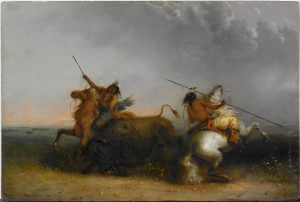
The last great buffalo hunts were here—traditional Native hunts of the last wild herd of 50,000 head. Buffalo Hunt, by Alfred Jacob Miller 1838. Amon Carter Museum.
Hey, how come no one knows about this? Why isn’t it in the history books?
Then, when they faced extinction, 5 buffalo calves were rescued here on the South Grand River and nourished by a Native American family, the Duprees, who gained international fame for helping to save the species.
They multiplied and today buffalo and deer again roam in our rugged buttes and badlands, forest service lands and grassy plateaus—lands that look much as they did 150 years ago.
Paying more attention, I listened to the stories, read a few more buffalo books. It was an awakening for me.
Wow! These are not cattle! Actually, more like wild animals—deer caught in the headlights.
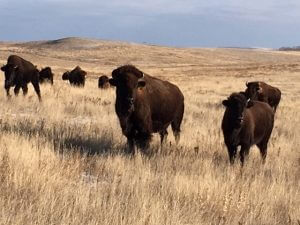
Buffalo are not cattle! More like wild animals, like deer caught in the headlights. Photo by Denise Anderson, Bismarck.
I’ve been collecting buffalo stories ever since.
For over 35 years I’ve been researching buffalo, reading every source I could find, visiting public, commercial and tribal herds, talking with down-to-earth bison ranchers from across the country, scrambling in the rocks above some of the most famous buffalo jumps in the Rocky Mountains, and writing three books about the majestic buffalo.
We now have a historic tour of 10 famous buffalo sites for you. More about that later.
People tell me that the more you get to know buffalo, the more you love them. It’s true, I’ve found.
Yes, along the way, it seems, I’ve been smitten by these magnificent animals. We’re so glad to have you along for the ride! And we think you might develop a passion for these majestic animals, too.
Getting to Know you, Our Readers
We want to get to know our readers. You and your family and your friends.
You can help us find the best buffalo stories. There are many.
We’ll also explore the science. Together we’ll venture along new trails. Dare to take least-travelled roads. Ask the perplexing questions.
With your help, we’ll cover a wide spectrum of buffalo lore and learning, and entertain you along the way.
And, yes, please warn us if we seem about to fall off a buffalo jump—or take a disastrously wrong turn . . .
1. First of all, we hope many of our readers are TEACHERS—you smart, busy people, always looking out for new and interesting ways to interact with students. We’re here for you.
2. We also hope to have your Students on board, especially Native American Youth, with your special awe and pride in buffalo.

Back to school. How about a buffalo story? Photo by Kuanish Reymbaev
3. Younger Kids, too—we’ll find some fun videos for you.
4. Also, please join us, Bison Experts—Scientists, College Professors, Forest
Rangers and Native Tribal buffalo managers. You wonderful people. We’re here to learn from you. Please don’t leave us. After all, you might be an expert who—once in awhile—just needs to smell those wild roses blooming along the buffalo pasture fence? We’ll help you!
5. Then of course, we want the Moms and Dads to join us—you busy, busy people,
pulled 6 ways from Sunday, a dozen new stresses every day. We wish you the peace and pleasure of contemplating a buffalo herd right here, online if not for real. You deserve the tranquility of enjoying an engaging buffalo photo or story for a few minutes
6. Also, we plan to have real Buffalo Ranchers on hand, you bold and adventurous women and men—who know your buffalo—and will tell us some of your wonderful stories. (And if we visit, maybe you’ll share a bowl of your delicious buffalo stew with us! Mmmm!) It’s been said, “Everyone who works with buffalo has a story.” We invite you to tell us a few of your own.

Buffalo ranchers Steve and Roxann McFarland work buffalo in the chutes on a cold January morning on their ranch southwest of Hettinger. Photo by Francie Berg.
7. Oh, and we’re not forgetting Grandmas and Grandpas! Looking for a bit of fun and new experiences when you open your computer? Maybe you live alone and it gets lonesome at times, doesn’t it? Need a friend? We promise you’ll meet herds of four-legged friends right here. But a word of caution, don’t expect the cuddly kind of friends! What we’ll bring you are sound and solid, four-feet-on-the-ground, no nonsense, but near-wild animals, who will gain your respect, and I think, in time, your affection.
And some fun stories too!
Enjoy the journey!
Want to Raise your own Buffalo Herd?
Wouldn’t that be fun!! Your own buffalo herd!
My Veterinarian husband—a practical man who soon gained buffalo experience—nixed that idea every time I brought it up.

“Buffalo are like rabbits! If you’re not careful, pretty soon you’ve got too many!” A Wyoming rancher warned her friends after watching their herd grow from 1 bull and 2 heifers to 500 animals—outgrowing their pastures. SD Tourism.
But there are many hobby buffalo farmers around. If you yearn to have your own buffalo, say, a bull and 2 cows—well, many buffalo ranchers, big and small, started in just that way.
They called it a “hobby herd.”
It’s not an entirely bad idea.
Just watch a group of Native American boys and girls visiting their own tribal herd. Note the pride and awe in their eyes, their silence and whispering voices, and you’ll have an idea of the respect these animals command, just by being themselves.
But watch out! Be warned of two things: they multiply and they’re not as gentle as they look.
“Buffalo are like rabbits! If you’re not careful, pretty soon you’ve got too many.” That’s what Toots Marquis, a woman rancher from Gillette, Wyoming, warned her friends.
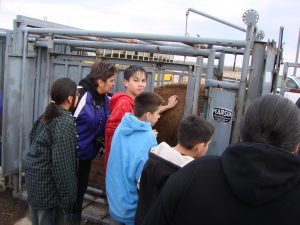
A group of Native American boys and girls from the Oneida Tribe in Wisconsin get a rare close-up view of their tribal herd on a field trip. Courtesy of Oneida Tribe.
The grandfather in her family bought a buffalo bull and two heifers, just for the novelty of it, to run with his cattle.
In what seemed like only a few years, they multiplied to 500 animals. By the time Marquis was left in charge by herself, she struggled to cull them back and keep the herd at around 75.
And don’t imagine that buffalo are going to be nice and cuddly.
Even playful calves bucking through a herd—don’t think you’ll join them. There’s more than one hostile mother watching, possibly all set to charge.
Don’t even think of posing for a selfie by edging close to a lethargic-looking bull. Remember the warnings, you’ll need something large—like maybe a pickup truck—between you and that big guy, just standing there watching you with what, deceptively, looks like sleepy eyes.
Don’t even think of posing for a selfie by edging closer to a sleepy-looking bull buffalo! He can spin on a dime and run 40 miles an hour! Instead, keep something big–like a pickup–between yourself and that bull. Video by WPLG TV station.
Their sleepy demeanor has fooled many. That bull can spin on a dime and run 40 miles an hour!
Can you? If not, then look out!
One day in 1906, a group of Mexican dignitaries came up the Missouri River in a tour boat to see Scotty Phillip’s buffalo herd in the badlands. They laughed at the big bulls, and boasted—with a bit too much exuberance—that their feisty Mexican fighting bulls would make short work of those lazy, slow moving bulls.
They challenged a bull fight—but that’s another story. We’ll tell you about the Mexican bull fight in Juarez another time (or you can read about it in Buffalo Heartbeats on page 182).
Then there are the fences. Are yours high enough? Strong enough?
You don’t have to own buffalo to enjoy them, of course. You can see them in many state and National Parks in the US and Canada.
In fact, I’m pretty sure everyone who has a passion for them might need to contemplate a live buffalo herd occasionally for a good measure of that peace and tranquility.
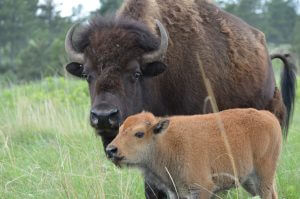
People tell me the more you get to know buffalo, the more you will love them. SD Game, Fish, Parks, photo by Chris Hull.
Don’t worry. Most of us can find buffalo around—in public zoos and parks, or private herds that you might view from the road, or nearby tribal herds which you can arrange to visit.
You might be surprised at the bison opportunities near where you live right now. If not, please come to see us on the Northern Plains, or contact your nearest Indian Reservation. They enjoy showing their buffalo herd to visitors.
_______________________________________________________________________
Coming next: Buffalo vs Bison — What shall we call them?
_______________________________________________________________________

Francie M Berg
Author of the Buffalo Tales &Trails blog


